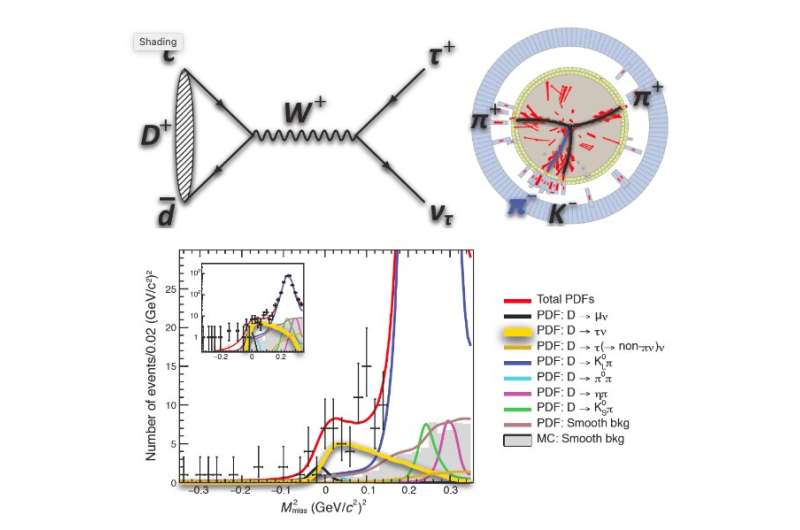December 10, 2019 feature
Study gathers the first observation of leptonic decay D+→τ+ντ

The Beijing Spectrometer III (BESIII) collaboration, a large team of researchers from universities worldwide conducting particle physics studies has recently reported the first observation of the leptonic decay D+→τ+ντ. This observation, presented in a paper published in Physical Review Letters, opens up the possibility of additional tests of mu/tau universality in D decays.
Before this study, there was only one experimental result related to the same leptonic decay, gathered by another group of researchers known as the CLEO collaboration. The CLEO collaboration, however, did not observe a signal for D+→τ+ντ and was merely able to set an upper limit, which was only 20 percent larger than the standard model's prediction for the rate of this decay. In their recent study, the BESIII collaboration set out to investigate this decay further, hoping that their large data sample would enable new discoveries.
"We recognized that a null result would be just as (or more) exciting, because it might reveal new physics beyond the standard model," Dr. Hailong Ma, co-convener of the BESIII charm group, told Phys.org. "There were major challenges, however, and even with ~3.6 times CLEO's data sample we knew that we would need better understanding of background processes and control of experimental systematics."
Electron-positron annihilations in the BEPCII electron-positron collider used by Ma and his colleagues at the energy of the psi(3770) resonance produce pristine samples of events, each with only a single D+ and a single D- meson. The researchers selected events in which the D- was fully reconstructed and tested whether the rest of the events was consistent with D+→τ+ντ, which contributes only one charged particle.
"For even this simple signal in the clean BESIII environment, there are high-rate background processes that can swamp the signal," Dr. Hajime Muramatsu, a researcher at the University of Minnesota who led the study, told Phys.org. "Suppressing the two largest of these, D+ -> pi+ pi0 and D+ -> pi+ K_L, was our biggest concern in designing our measurement. These processes can be mistaken for our signal when they are incompletely or incorrectly reconstructed and for our analysis we came up with two new tools for background suppression."
One of the two tools for background suppression devised by the BESIII collaboration entails eliminating events in which the missing momentum points outside the active detector in order to avoid mistaking escaping particles for undetectable neutrinos. The missing momentum is calculated from the properties of the annihilating electron and positron, as well as the detected final-state particles.
The second tool devised by the researchers, on the other hand, works by rejecting background events based on the additional energy deposits that they can produce in the electromagnetic calorimeter of their detector. This particular requirement efficiently accepts signal events, for which the only extra particles are neutrinos that penetrate the detector without leaving a trace.
The BESIII collaboration's observation of leptonic decay D+→τ+ντ fills an important gap in the standard model of particle physics, enabling new tests of the model. A key feature of the standard model is 'lepton universality," which mandates that the electron, muon and tau behave almost identically in all interactions.
"Recent measurements of decays of B mesons hint at possible violation of lepton universality, making it even more interesting to perform tests on the charm mesons D and Ds," Prof. Ron Poling, a researcher at the University of Minnesota involved in the study, told Phys.org. "There are many results on Ds+ -> tau+ nu that are somewhat scattered but largely consistent with the standard model prediction. Because D+ -> tau+ nu had never previously been seen, our study provides the first opportunity to test for mu/tau universality in D decays."
The recent study by the BESIII collaboration demonstrates that the leptonic decay D+→τ+ντ rate conforms to theoretical expectations within experimental uncertainty, thus reinforcing confidence in the standard model. The first measurement of D+→τ+ντ they collected, based on ~3/fb e+e- annihilation data, is statistically limited (i.e., with a 20 percent relative statistical uncertainty on the decay rate and lepton-universality test). In the future, larger datasets and additional statistics could pave the way for more specific measurements.
"BEPCII and BESIII are planning to take more data in the near future and to upgrade both accelerator and detector capabilities," Prof. Changzheng Yuan, BESIII spokesperson, told Phys.org. "We have proposed to collect 20/fb of psi(3770) data in the future, reducing the relative statistical error for the D+ -> tau+ nu measurement to less than 8 percent. BESIII will also use this and large data samples at other energies to refine our understanding of similar decays of Ds meson and to extend many other investigations of charmed mesons, charmed baryons and other states."
More information: M. Ablikim et al. Observation of the Leptonic Decay D+→τ+ντ, Physical Review Letters (2019). DOI: 10.1103/PhysRevLett.123.211802
B. I. Eisenstein et al. Precision measurement ofB(D+→μ+ν)and the pseudoscalar decay constantfD+, Physical Review D (2008). DOI: 10.1103/PhysRevD.78.052003
Journal information: Physical Review Letters , Physical Review D
© 2019 Science X Network





















